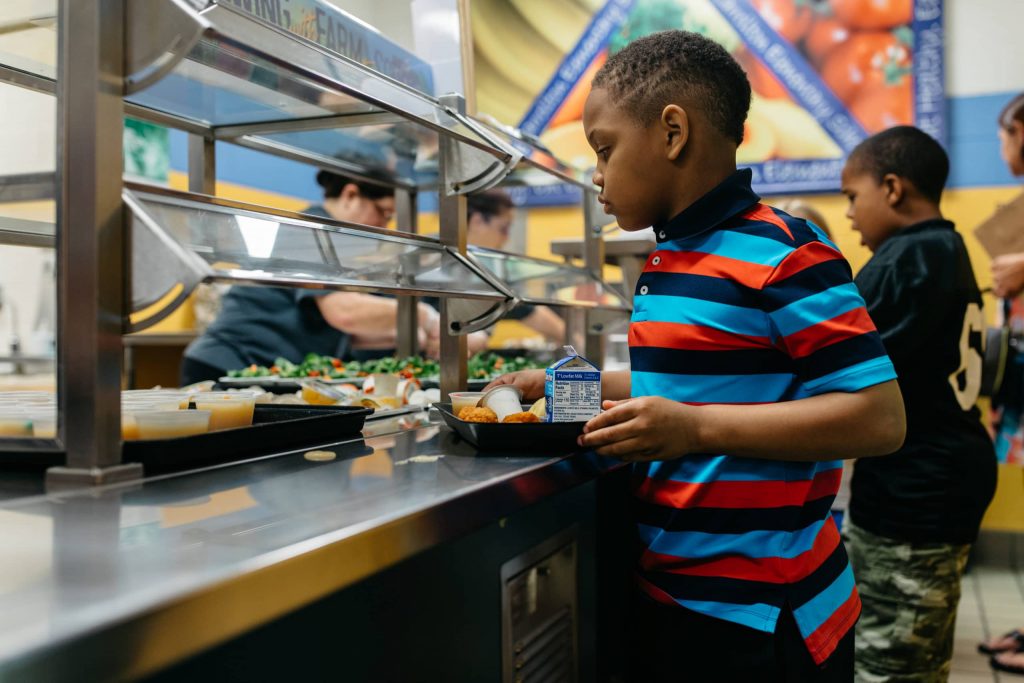Our Hidden Infrastructure Crisis: School Cafeterias
Too many school kitchens and cafeterias are ill-equipped to serve nourishing, delicious meals.
Too many school kitchens and cafeterias are ill-equipped to serve nourishing, delicious meals.

This piece was originally written by Cecily Upton & Dorothy S. McAuliffe for The Hill.
Every day, millions of parents head to work using roads, highways, transportation networks and public transit systems funded by our federal dollars. At the same time, millions of kids head to school to prepare for their futures: a long day of lessons, extracurriculars, engaging with classmates, and a school meal (or two, or sometimes three).
Lawmakers of all stripes regularly bemoan the lack of meaningful investments in our transportation infrastructure, and we agree it’s a real problem. But on the other side of the work day, we often don’t think about the place where nearly 50 million kids get the fuel that powers their learning — the school cafeteria. Too often, our school cafeterias are even more inefficient and unwelcoming than those crumbling roads, bridges and subways.
School nutrition directors and their staff work hard day in and day out, stretching pennies as far as they go in pursuit of the most nutritious and delicious meals possible. They do heroic work, but they are held back by the tools available to them. School cafeterias are critically under-resourced, suffering from outdated equipment and woefully ill-equipped to meet the needs of our kids. The price we pay for not investing is not measured in dollars and cents, but in our kids’ health and diminished educational potential.
The National School Lunch Program turns 73 this year, and many of our school cafeterias are nearly as old. The most recent data on school kitchens — from 2012 — found 88 percent of school districts needed at least one new piece of equipment. Some school kitchens rely on ancient, inefficient appliances because they lack the resources to upgrade to more modern cooking technologies. Others must feed hundreds, sometimes thousands of kids each day with nothing more than a freezer and a microwave.
In these schools, kids are limited to heat-and-serve meals from heat-and-serve kitchens — a far cry from the fresh, appealing and delicious meals that help them feel and do their best at school. This reality is especially dire for the millions of kids whose school lunch might be the only meal they’ll eat that day. The connection between nutritious food and academic performance is intuitive, but also backed by a significant volume of research. Kids can’t be hungry to learn if they’re just plain hungry.
Investing in our kids should be reason enough to improve cafeterias, but the consequences of under-resourced school kitchens don’t stop there. In outdated kitchens, schools cannot support skills development and professional advancement for their cafeteria workers — a missed opportunity to transform these positions into durable, 21st-century jobs. And when local produce, fish, meat and other foods lose out to pre-packaged, mass-produced items for a spot on the lunch tray because the school kitchen lacks the equipment, capacity and skills to prepare and store them, local farms lose a valuable, consistent market for their products. School food and equipment purchasing can be a powerful economic driver in many local economies.
Furthermore, the U.S. economy alone loses more than $1.7 trillion each year to diet-related diseases — many of them rooted in what we feed our kids. This problem especially affects kids already marginalized in other ways, namely students of color and from low-income families. Children who can’t access a quality diet are more likely to face a lifetime of challenges; they score lower on tests, miss more days of school, and advance less in their careers.
So, what’s the recipe to fix this problem? Congress has to start thinking about our school cafeterias as a necessary infrastructure investment. They can do that by passing the bipartisan School Food Modernization Act — a proposal introduced by Sen. Susan Collins (R-Maine) and Sen. Tina Smith of (D-Minn. ) — to help schools acquire new equipment to prepare and serve healthier meals.
Cafeterias can and should be joyful places — sites of comfort and connection where our kids can take a nourishing break from the school day. In FoodCorps’ 10 years working in schools, we’ve seen tried-and-true practices like scratch cooking and farm-to-school procurement revolutionize school cafeterias and the learning communities they feed.
Take Prince William County Public Schools in northern Virginia, where school nutrition leadership prioritized scratch cooking techniques and healthier ingredients. Every kitchen in the district is outfitted with a combi-oven, facilitating the preparation of menu items like fresh-baked rolls and homemade pasta sauce. And the kids who get to enjoy these tasty meals aren’t the only winners; cafeteria staff reap the rewards of better job training and skills development.
And it’s not just about cooking; other appliances can impact what kids eat, too. With the help of an industrial blender, fruits and veggies transform into delicious, appealing, kid-friendly smoothies. To serve wedges of whole local produce, try a tool called a sectionizer, which can quickly cut food into easy-to-eat pieces.
Research shows kids are more likely to eat fruits and vegetables after trying them multiple times, and after learning about healthy food through engaging, hands-on lessons. It seems intuitive, then, to strive for cafeterias where sampling healthier food is not a special occasion, but standard practice. Why not invest in robust, practical cafeterias that embody this same idea — especially when the benefits are limitless?
Cafeterias are opportune places for addressing some of our nation’s biggest challenges. But like other elements of public education we often take for granted, they can’t live up to their full potential without the proper resources. A modest investment in the School Food Modernization Act could bring about transformational change: more jobs in communities, stronger local farms and economies, and thriving kids. We have a responsibility to create a strong, sustainable foundation for school cafeterias. Our kids are counting on us.

FoodCorps in the News: 2024

FoodCorps’ Statement on the 2024 Election

FoodCorps Welcomes Rachel Willis as Interim President